Every person who sets out to lose weight begins to look for a set of magic exercises for losing weight: burning more, exercising less and not giving up the usual sweets and fast food.
It is important to understand that playing sports for weight loss is a competent combination of physical activity and proper nutrition. As some trainers say, all training begins in the kitchen.
Today we will understand the intricacies of competent training, exercises and execution methods, setting up a typical training week and adjusting the diet.

How to exercise to lose weight
There is no universal set of exercises that will suit everyone and guarantee weight loss in the shortest possible time. Nevertheless, you can create your own plan structure based on a few basic principles and choose the exercises that are more suitable based on your technical, physical and temporal capabilities.
If the goal of training is to lose weight, what is recommended to pay attention to:
- Combine strength and cardio exercises. You are not tasked with becoming a bodybuilder or a marathon runner, so don't overdo it. Find a happy medium by spreading the load evenly throughout the week.
- Alternative training in different directions. Thus, you will have enough time to recover the involved muscles - you can train more often and more. For example, if your plan is to run on Monday, strengthen your arms on Tuesday and spin the bike on Wednesday.
- Do not exercise when you are tired. If you've had a hard day at work, haven't gotten enough sleep, or had a long flight on a business trip, there's no need to skip an evening workout. Despite the supercompensation effect promoted by motivational videos (increasing the initial level of the body's abilities after intense training), it will only work against the background of normal recovery, including nutrition and sleep.
- Match your diet to your workouts. You should not train on an empty stomach, especially if you do not have relevant experience, you should not go to training immediately after breakfast. The optimal time for classes is two to three hours after eating.
- The most effective for burning fat are interval training, in which periods of intense load are alternated with short periods of rest or low-intensity exercise. One option for interval training can be circuit training, where intense strength training in the gym is alternated with short cardio - jogging or brisk walking.
- Don't expect immediate results. Weigh yourself every day and evaluate your progress, no need to look at deviations in grams. Untrained people typically take six to eight weeks to adapt to exercise, after which fitness levels allow for higher intensity workouts and longer workouts that burn more calories and fat.
- For beginners, 300 minutes of moderate intensity exercise per week is enough. These include: brisk walking, running, cycling, swimming, strength and circuit training in the gym, jumping rope, outdoor exercise equipment, hill and trail walking. Spread the load evenly over the days. This could be five one-hour workouts a week, or three one-hour workouts during the week and a long two-hour bike ride on the weekend.
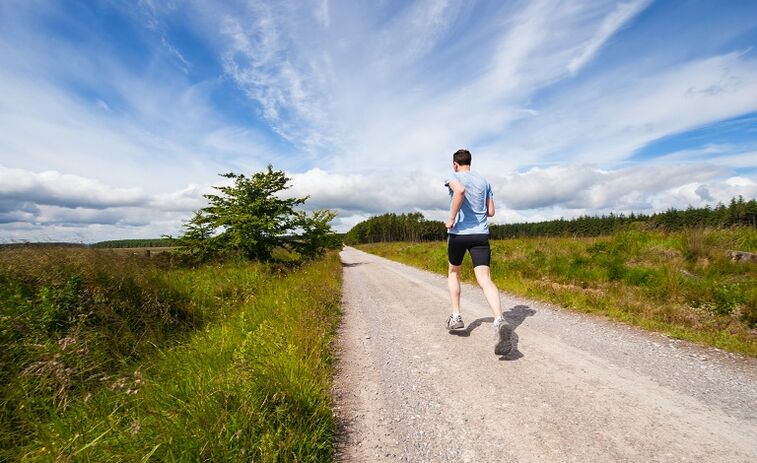
A set of exercises to lose weight
Let's say the average person works a standard 5/2 schedule and only has the opportunity to work out on weekdays as well as weekends.
Since athletic performance plays a secondary role during weight loss, you should not train every other weekend. Leave yourself a day for complete relaxation. First, it is necessary to recover physically after a working week, and secondly, it will allow you to take a mental break from the training process that will permeate the weekly schedule to lose excess weight.
Examples of training weeks:
| Day of the week | Option 1 | Option 2 | Option 3 |
|---|---|---|---|
| Monday | Strength training in the gym | Strength training in the gym | Light cardio exercise |
| Tuesday | Light cardio exercise | Outdoor exercise | Strength training in the gym |
| Wednesday | Rest | Rest | Circuit training |
| Thursday | Strength training in the gym | Light cardio exercise | Rest |
| friday | Circuit training | Strength training in the gym | Strength training in the gym |
| Saturday | Long-term cardio | Rest | Long-term cardio |
| Sunday | Rest | Long-term cardio | Rest |
Strength training in the gym
Strength training, including resistance training, helps increase muscle tone, increase strength, and build muscle mass over time. Weights include dumbbells, barbells, weights, expanders and various simulators.
Strength training is important because it allows you to maintain muscle mass and strength while shedding excess fat. They have also been shown to increase bone density, which in turn reduces the likelihood of developing osteoporosis with age.
Examples of effective fat burning exercises in the gym:
Mahi from the river
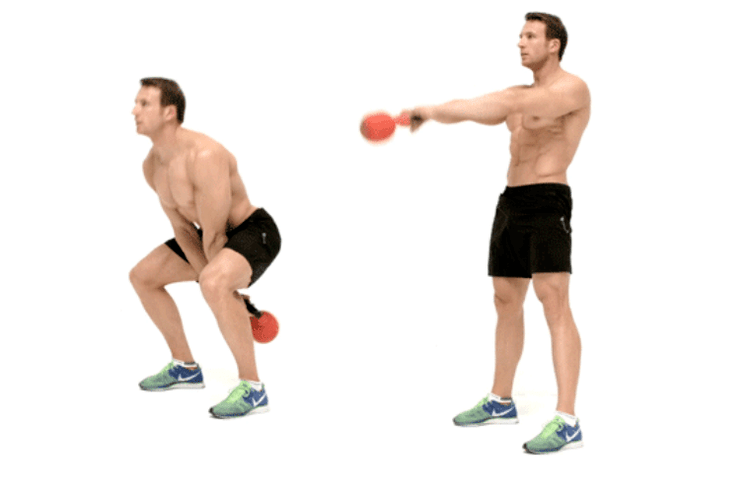
Kettlebell swings are extremely easy to learn and one of the most effective fat burning exercises because it engages the gluteal muscles, hips, abs, back, arms and shoulders at the same time.
Technique:
Stand straight with your feet shoulder-width apart and knees slightly bent. Hold the weight between your legs with both hands. Lean back slightly, at the same time straighten your legs and move the kettlebell forward with straight arms. The weight will do the reverse movement itself. The task is to bend your knees slightly and release them back like a pendulum. Each swing movement is given from the feet to the arms.
Typical mistakes:
- Do not round your back, it should be straight.
- Do not try to lift the kettle. All swings are done by inertia due to the movements provided by the legs.
- Do not move the kettle too far. This will put more stress on the shoulder joints and can lead to injuries.
- Do not lift too much weight. The meaning of the exercise is to include a large number of muscles and technically correct execution and not to lift significant weight.
Squat with dumbbells
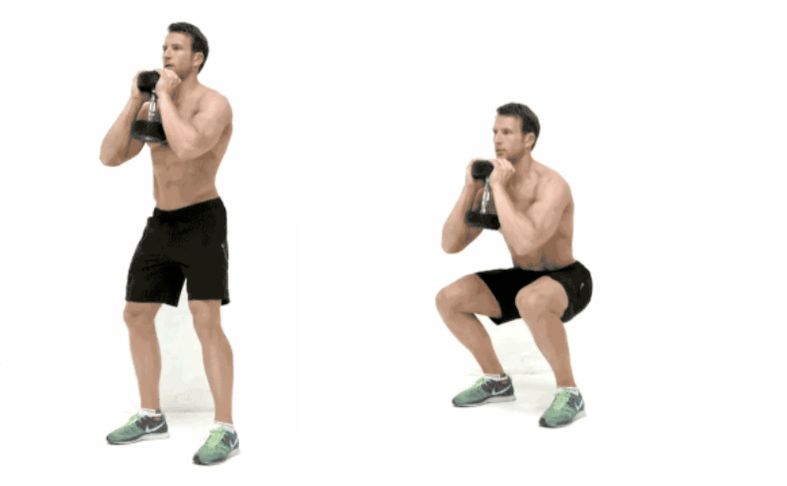
Squats are the main exercise for leg development. If squatting with body weight is easy for you, but you are afraid to switch to barbell exercises, start with an easy option - dumbbell squats. This exercise covers the back, abs and arms in addition to the legs.
Technique:
Stand straight. The feet are slightly wider than the shoulders. Hold a dumbbell with both hands at one end and raise it to chest level. Begin squatting until your thighs are parallel to the floor. Slowly rise to the starting position. The legs should be still.
Typical mistakes:
- Heel off the floor. If you start jumping up and down to get to the starting position, then you have picked up a dumbbell that is too heavy.
- Don't round your back. Stay straight both above and below.
Overhead dumbbell or kettlebell presses
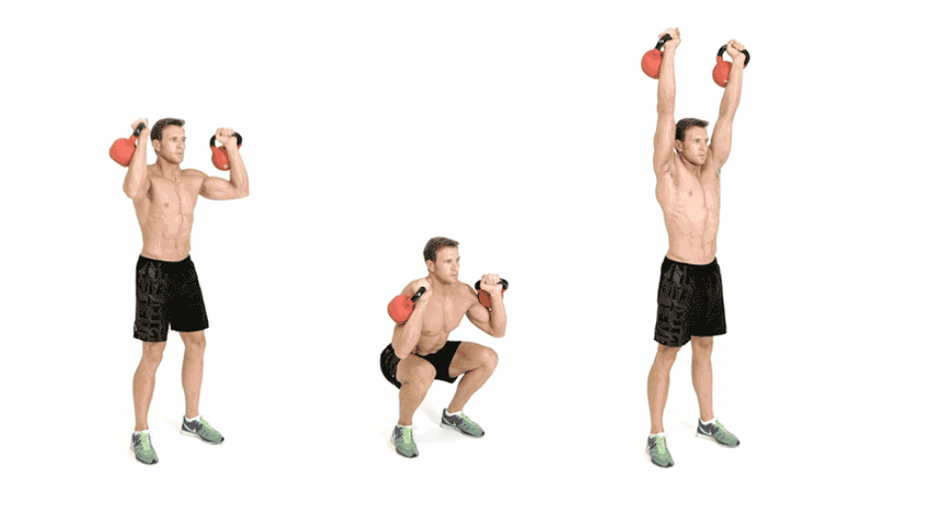
This exercise can be performed both statically and dynamically, combining bench presses with squats will allow you to burn more calories and fat. The dynamic version includes almost all major muscle groups - hips, hips, back, abdomen, arms, shoulders.
Technique:
Stand straight, feet slightly wider than shoulders. Hold a dumbbell or kettlebell in each hand. Bend your elbows, the shells should be above your shoulders. Squat until your thighs are parallel to the floor. Press the dumbbells / kettlebells above your head as you rise to the starting position at the top. Return your hands to their original position.
Typical mistakes:
- Do not pick up very heavy shells. It is easy to get injured in dynamics, so it is better to work with the lightest dumbbells / kettlebells during the stage of getting used to and mastering the technique.
- Don't lift your heels off the floor, as this will destabilize you - you can lose balance due to the extra weight on your hands.
- Do not squeeze the dumbbells / weights after standing up. Use the speed you set with your legs from the low point. All movements are performed in dynamics, as in training with a swing from a river.
farmer's walk

A farmer's walk is a heavy walk. This exercise, due to the additional weight, increases the load on the legs, and also includes the shoulders, arms, back and abs.
First, take a pair of dumbbells or kettlebells with a total weight of 25-30% of your body weight and take 20-40 steps. If it's easy, you can add weights or make the exercise harder and skip it.
Dumbbell bench press
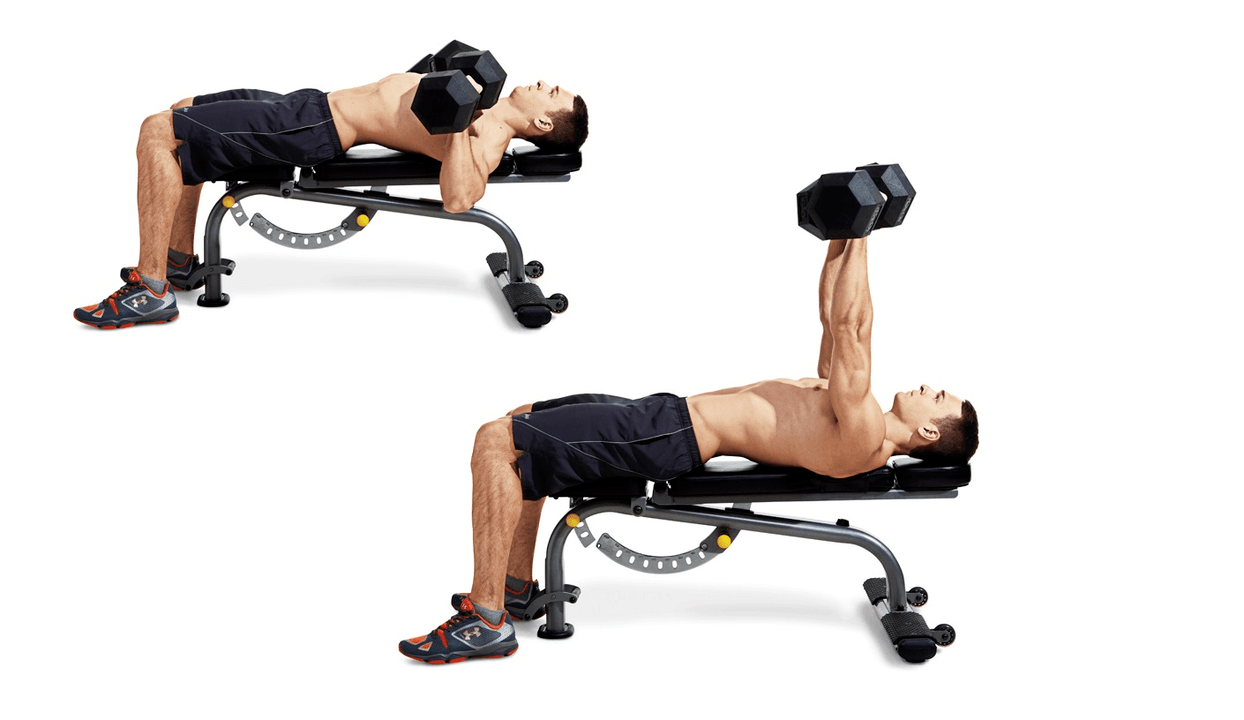
The bench press actively covers the upper part of the body - pectoral muscles, shoulders, arms.
Technique:
Hold a dumbbell in each hand and lie on a bench. Spread your feet slightly wider than your shoulders and press your heels firmly into the floor. Tighten your abdominal and back muscles. Push the dumbbells above your chest until your arms are straight. Slowly return them to their original position.
Typical mistakes:
- Do not relax your hands while moving down. This can lead to shoulder injury.
- Do not lift dumbbells that are too heavy, as this increases the risk of injury. You should be comfortable doing 8-12 reps per set.
Circuit training
The good thing about circuit training is that you can incorporate almost any exercise you can do at a moderate or fast pace.
Key points to consider when planning a circuit workout:
- Alternate exercises for different muscle groups to relax your arms, legs, back and abs.
- The duration of the intensive interval should not exceed one minute, otherwise the exercise will turn into endurance work. It is important that you perform this interval at a fast or moderate (in the case of weight training) speed.
- The duration of a low-intensity interval (walking, jogging) or rest should not exceed 30 seconds.
- The total duration of the exercise should be 15-20 minutes.
Examples of exercises:
- impulses;
- lifting bent legs hanging on a horizontal bar;
- to squat;
- dynamic core exercises - rock climber, bicycle;
- stretching - skipping lunges with changing legs;
- bending dumbbell row;
- swing weights;
- press a dumbbell above your head;
- burpees;
- thrust on uneven bars;
- box jump;
- skipping rope;
- alternate leg raises in plank.
Assemble a block of four to eight exercises in a circle. Each exercise is performed for 30-60 seconds with a 30-second rest. Rest between circles - a minute or two, or light jogging if you exercise outside or if the gym allows. Complete three to five rounds until the total workout time approaches 15 to 20 minutes.
Light cardio exercise
Light cardio is a low to moderate intensity workout of no more than an hour. For beginners, it is best not to exceed 30 minutes until you feel that your cardiovascular system has adapted to the point where you can exercise without holding your breath.
One of the indicators of cardiovascular fitness is the speech test. If you can carry on a conversation while doing cardio, then the intensity of the load will allow you to train for quite a long time.
Light cardio exercises include:
- running;
- pedaling an exercise bike or bicycle;
- lessons on a stepper;
- skipping rope;
- swimming;
- skiing.
Long-term cardio
Long exercises differ from easy ones only in terms of time spent. Try to maintain the same intensity that allowed you to complete the speaking test.
To combine business with pleasure, join a running club for weekend runs, cycle with friends in the countryside or go for long walks over hills and rough terrain.
Typical mistakes:
- Don't start too fast. You don't have to leave everything right away. Instead, start your run with a brisk walk and slowly transition to a jog. When cycling, do not climb the mountain immediately, ride at a slow speed on a smooth road for 10-20 minutes.
- Don't train at a strict time. Pay attention to your feelings. You don't need to push yourself if you're tired.
- Don't forget to drink water or isotonic drinks, especially in summer. During prolonged exercise, the body loses fluid through sweat, so these losses must be replenished.
Exercise Tips
- Any exercise starts with a warm-up and ends with a cool-down. Warming up is necessary to warm up the muscles and reduce trauma, an obstacle is to cool down smoothly and reduce blood circulation in the body.
- Do not train the same way two days in a row. Let your muscles relax.
- If you can't do a certain exercise, replace it with a similar one. You can walk on the stairs instead of running, do push-ups from the floor instead of dumbbell presses, pull-ups on the block simulator instead of pull-ups. The same muscle group can be loaded with different exercises.
- Start with small weights and gradually increase the load. Linear progress happens only at first, then it will be more difficult for you to add weight, because it takes more time for ligaments, tendons and muscles to adapt. Overzealousness and the desire to shake the barbell more can lead to serious injuries and forced breaks in training.
- If you feel that you are very tired, take a break for two or three days so that the body can recover. Periodically organize an unloading week, for example, once a month, when the load is 50-75% of the usual. During the loading week, you can remove one or two exercises or simply reduce the time of each session by 15-30 minutes.

Diet tips for weight loss
- Breakfast should be rich in healthy and slow carbohydrates: cereals, whole grains, bananas. Carbohydrates are not only fuel for working muscles (carbohydrates from food are stored in the muscles and liver in the form of glycogen), but also a source of glucose for the normal functioning of the brain.
- Don't look for a quick fix on the fad low-carb and keto (high-fat diets). Stick to your doctor's recommended balance of proteins (10-30%), fats (25-35%) and carbohydrates (45-65%) and adjust your diet based on how you feel.
- To lose weight, you need to be in a calorie deficit. This means that you should spend a little more than you consume. Consumption includes the average needs of the body for normal functioning, as well as calories spent during exercise. Consumption should be reduced evenly among all components (proteins, fats and carbohydrates), not at the expense of only one, as is customary in a low-carbohydrate diet.
- If you want to calculate everything accurately, install an app on your phone where you will enter all the food you eat during the day. Special applications have their own database, where a certain calorie and BJU balance is recorded for each product. Over time, you will understand where you can cut extra calories without harming the body.
- Nutrition before training should be sports - pay attention to foods that provide enough energy for training. Avoid "empty" calories from fast food and sugary drinks.
- Post-workout meals should include foods rich in protein and slow carbohydrates to ensure muscle recovery and energy reserves. Suitable for these purposes: cottage cheese and fruits, chicken or cheese salad, sandwich with turkey and fresh vegetables, chicken breast with rice.
- Drink enough water. Losing weight through dehydration isn't the best idea, especially when you're sweating profusely during exercise. At the same time, forcing yourself to pour two or three liters of water is not worth it. The body itself will tell you when the lost fluid needs to be replenished.















